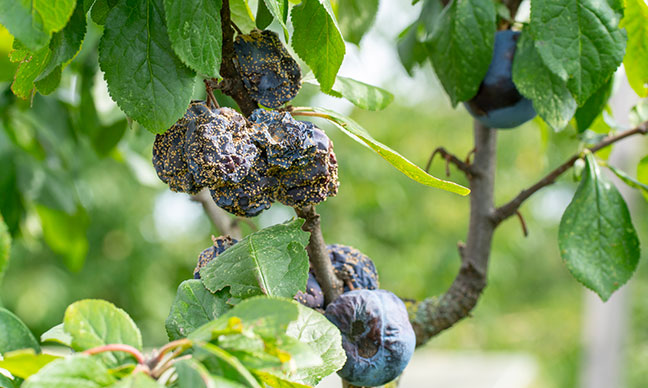Problems with plum tree diseases are diverse and they are the result of fungal and bacterial spores, wind spread viruses, and sometimes even splashing water. These diseases usually end up slowing or completely stopping the production of the fruit crop. Due to these reasons, you need to control plum tree pests as soon as you notice any of the symptoms we will list below.
Keep reading to learn more about the Santa Rosa plum diseases, problems, symptoms, prevention, and care!
Plum Tree Diseases – Common Santa Rosa Plum Problems
1. Brown Rot
Brown rot is one of those plum tree diseases that affect the flowers, fruit, and twigs of the plum tree. The flowers will dry up and turn brown, but they usually won’t fall off. Some brown spots over the fruit are a very common symptom, and these are followed by lighter-colored spores. The leaves at the ends of the twigs shrivel in most cases. In addition, brown sticky goo and sunken areas will appear where the flower attaches to the twigs.
Tree services California recommend pruning out the diseased branches. Also, avoid getting the foliage wet when you’re watering the tree to limit the spread of this disease. Consider applying copper-containing fungicide after buds appear, just do it before the tree blooms.
2. Bacterial Canker
Bacterial canker is a disease that appears as brown water spots on the bark of plum trees. During the spring, these spots secrete a sticky substance. Additionally, the cankers will eventually spread to other parts of the tree, causing shriveled blossoms and sunken spots on fruit and leaves. Unlike other plum tree pests and diseases, bacterial canker symptoms are more widespread during cold weather.
In order to prevent the diseases, you will have to plant your Santa Rosa plum tree in deep, well-draining soil. In addition, we recommend applying macronutrients in the spring and practicing dormant winter pruning. Keep in mind to remove infected limbs in the summer.
If you’re unsure how to do this by yourself, it is always better to hire a tree service Santa Rosa to help you with it. An untrained hand can easily damage the tree and just cause more problems.
3. Plum Leaf Scald
Plum leaf scald is a type of bacterial leaf scorch that causes brown or burned patches around the edges of the leaves. The tree will eventually decline completely and die if enough foliage is infected and nothing is being done about the symptoms. The main cause for the disease are leafhoppers – they spread the bacteria that causes leaf scald. Sadly, nothing can be done to eradicate the disease once the tree is infected.
In some cases, pruning infected limbs can help slow down the spread. In addition, regularly maintaining the tree will also make the tree less likely to develop this disease, so we recommend hiring your local arborist to take care of your trees.
4. Black Knot
Black knot is a fungus causing black galls on twigs and smaller limbs of the Santa Rosa plum tree. The galls quickly spread along the branches after the blooms, when they form. The black knots harden in the fall, so it is ideal if you can notice them before the tree goes dormant.
For this reason, we recommend recommending infected limbs at least 4 inches past the galls into healthy wood. Do this during the winter if you haven’t previously cured the tree of the disease. As for other plum tree pests and diseases, a copper-containing fungicide can be really helpful in the spring before the buds open to help control the disease.
5. Plum Pocket
The plum pocket disease is characterized by discolored, hollow, and swelling fruit. All of these symptoms may cause different problems within the tree itself, too. This is why the fast reaction is absolutely necessary. Hollow fruit that’s infested will be itching to burst and will eventually spread to other trees in the area.
The disease will return every year once it is established. Good care for the tree and prevention is most effective in stopping this disease from even happening. In addition, fungicides may also be helpful, but you need to be very careful with the symptoms if they ever show up.
6. Plum Pox Virus
Plum pox virus can be spread through grafting of affected plants but is normally transmitted via aphids. This is one of the more dangerous diseases since there is no treatment for it once a tree is infected. In order to prevent further infections to nearby plans, the infected tree needs to be removed immediately.
Discolored rings on fruits and leaves are the most common symptoms. In addition, you may prevent the disease by controlling aphid populations.
FAQ
Q; How do I get rid of fungus on my plum tree?
A: To get rid of fungus on your plum tree in Santa Rosa, we recommend pruning out all infected branches in late winter. In addition, make sure you burn, bury, or throw the pruned branches away to stop the fungus from returning to the tree.
Q: How do you treat plum tree disease?
A: Plum tree diseases are usually quite hard to treat in Santa Rosa. However, regular pruning, trimming, and using fungicide may prevent diseases from even occurring. In addition, hiring a tree service will be of great help when it comes to treating plum tree diseases.
Q: What do you spray plum trees with?
A: Spray plums with permethrin, esfenvalerate, or spinosad once the fruit begins to develop and the husks are pulling back from the fruit. In addition, you can sprat your plum trees in Santa Rosa with malathion, sulfur, and fungicide to control scab, plum pocket, and leaf curl.
Local Tree Experts Overview
Plum tree diseases can be quite tough to deal with. However, with proper care, maintenance, pruning, and the use of fungicide, you may prevent the diseases from attacking your trees. To do this properly, we recommend hiring an arborist to help you with everything you need when it comes to preventing plum diseases!




